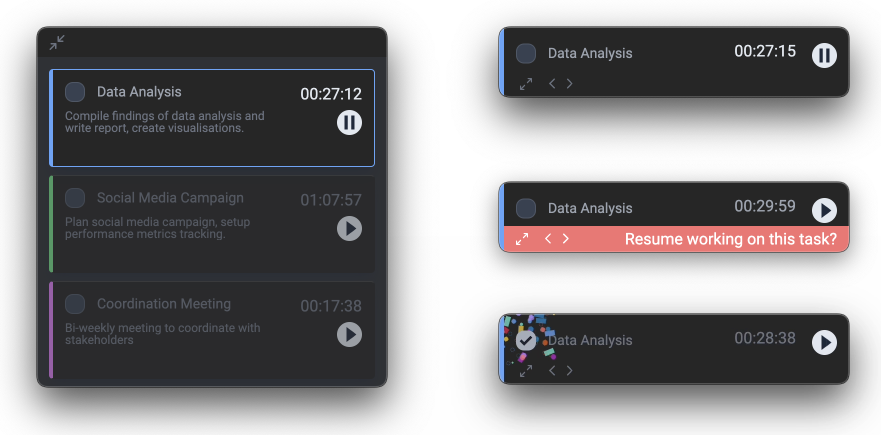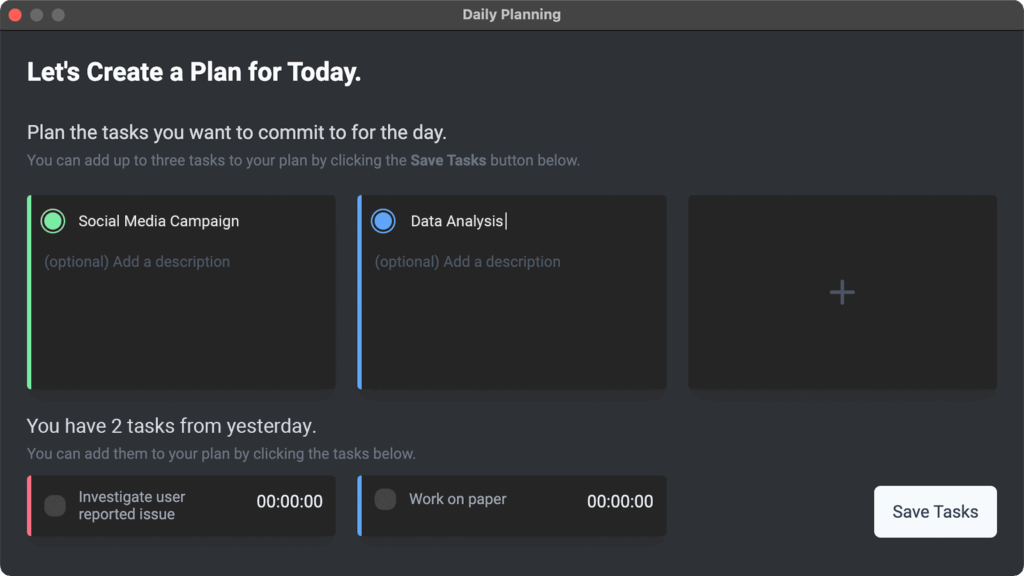18.06.2025 by Isabelle Cuber
‘Stick to’ Three: Fostering Awareness, Intentions, and Reflections on the Top Daily Tasks
![]() Many of us who navigate digital tasks throughout the day have experienced how difficult it can be to stay focused on what really matters. Between to-do lists, notifications, and shifting priorities, it’s easy to feel busy without actually making progress on the most important work. In this blogpost, we explore how AIRbar, a lightweight task management tool, could help address this challenge by encouraging awareness, intention, and retrospection in everyday work.
Many of us who navigate digital tasks throughout the day have experienced how difficult it can be to stay focused on what really matters. Between to-do lists, notifications, and shifting priorities, it’s easy to feel busy without actually making progress on the most important work. In this blogpost, we explore how AIRbar, a lightweight task management tool, could help address this challenge by encouraging awareness, intention, and retrospection in everyday work.
Task Management in Knowledge Work
Task management is a central part of daily life for many knowledge workers, who often need to balance multiple projects, deadlines, and communication channels at once. But staying on top of these demands is often not easy. Priorities shift throughout the day, to-do lists grow fast, and we often fall into the trap of the planning fallacy: overestimating how much we can get done and underestimating how long things will take. As a result, many workers can end up feeling overwhelmed or scattered. To help with this, we built AIRbar: a lightweight task management tool grounded in three core design concepts: awareness, intention, and retrospection.
Awareness, Intention, and Retrospection
The first concept, intention, is supported by prompting users to define their most important tasks at the start of each day. To reduce the risk of overplanning, users are limited to selecting just three tasks.
The second concept, awareness, recognizes that planning and prioritization alone are often not enough to ensure follow-through. To support awareness of the day’s tasks throughout the day, AIRbar includes an always-on, glanceable widget that remains visible on the screen. This design was inspired by the way people use sticky notes placed in strategic locations to avoid forgetting important tasks. With the widget, users can track time spent on a task, switch between tasks, and mark them as done.

The third concept, retrospection, is about encouraging users to reflect on their work at the end of the day. AIRbar provides visualizations and insights into the day’s task activity. The goal is to prompt reflection on how the day went and to help users develop a better understanding of their work patterns and task management.![]()

![]() To understand how AIRbar supports daily task management in practice, 35 knowledge workers installed the tool on their work computers for four weeks. During this time, different phases of the study enabled either some, all, or none of AIRbar’s features. We collected tool usage data throughout the study, in addition to surveys and interviews to capture participants’ experiences and perceptions.
To understand how AIRbar supports daily task management in practice, 35 knowledge workers installed the tool on their work computers for four weeks. During this time, different phases of the study enabled either some, all, or none of AIRbar’s features. We collected tool usage data throughout the study, in addition to surveys and interviews to capture participants’ experiences and perceptions.
How AIRbar Shaped Daily Task Management
When all AIRbar features were enabled, participants completed more tasks and reported higher satisfaction with their task management. In addition to that, we also gathered deeper insights into how the different design components shaped participants’ experiences:
-
Morning intention prompts helped bring structure and focus to the start of the day. The limit of three tasks encouraged users to prioritize realistically and avoid overcommitting.
-
The always-on widget supported task commitment throughout the day. For some, the visible task list served as a helpful reminder and made it easier to return to their priorities after interruptions. Time tracking was seen by several participants as a source of accountability, but for others, it introduced stress or pressure.
-
End-of-day retrospection led many participants to reflect on their progress and adjust their approach for the next day, reinforcing a cycle of awareness and continuous improvement.
These findings suggest two important directions for future systems. First, rather than eliminating unpredictability in knowledge work, we should design tools that help users navigate it more intentionally. Second, there is a clear need for more assistive support during task planning, moving toward systems that not only record tasks but actively help users define and manage them more effectively.
To find out more about the design and implementation of AIRbar, please check out our publication.
| Authors |
André N. Meyer, Nimra Ahmed, Isabelle Cuber, Sebastian Richner, Elaine M. Huang, Gail C. Murphy, Thomas Fritz |
| Conference |
DIS’2025 |
| Pre-Print | |
| Download AIRbar |
|







